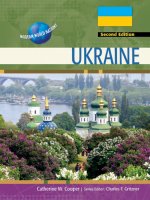- Trang chủ >>
- Khoa Học Tự Nhiên >>
- Vật lý
Modern world nations france
Bạn đang xem bản rút gọn của tài liệu. Xem và tải ngay bản đầy đủ của tài liệu tại đây (64 KB, 127 trang )
CH.MWN.Fra.aFM.Final.q 7/19/03 5:26 PM Page 1
AFGHANISTAN
IRAN
ARGENTINA
IRAQ
AUSTRALIA
IRELAND
AUSTRIA
ISRAEL
BAHRAIN
ITALY
BERMUDA
JAPAN
BOLIVIA
KAZAKHSTAN
BRAZIL
KENYA
CANADA
KUWAIT
CHINA
MEXICO
COSTA RICA
THE NETHERLANDS
CROATIA
NEW ZEALAND
CUBA
NIGERIA
EGYPT
NORTH KOREA
ENGLAND
NORWAY
ETHIOPIA
PAKISTAN
FRANCE
PERU
REPUBLIC OF GEORGIA
RUSSIA
GERMANY
SAUDI ARABIA
GHANA
SCOTLAND
GUATEMALA
SOUTH AFRICA
ICELAND
SOUTH KOREA
INDIA
UKRAINE
CH.MWN.Fra.aFM.Final.q 7/19/03 5:26 PM Page 2
CH.MWN.Fra.aFM.Final.q 7/19/03 5:26 PM Page 3
France
Stephen C. Jett
Series Consulting Editor
Charles F. Gritzner
South Dakota State University
Philadelphia
CH.MWN.Fra.aFM.Final.q
7/23/03
3.26 PM
Page 4
Dedicated to the memory of
Jacques Robelin, Joséphine Clément, and Henriette Moureau,
and to Marie-Madeleine Robelin
Frontispiece: Flag of France
Cover: Paris with the Eiffel Tower in the distance.
CHELSEA HOUSE PUBLISHERS
VP, NEW PRODUCT DEVELOPMENT Sally Cheney
DIRECTOR OF PRODUCTION Kim Shinners
CREATIVE MANAGER Takeshi Takahashi
MANUFACTURING MANAGER Diann Grasse
Staff for FRANCE
EXECUTIVE EDITOR Lee Marcott
PRODUCTION ASSISTANT Megan Emery
PICTURE RESEARCHER 21st Century Publishing and Communications, Inc.
SERIES DESIGNER Takeshi Takahashi
COVER DESIGNER Keith Trego
LAYOUT 21st Century Publishing and Communications, Inc.
©2004 by Chelsea House Publishers, a subsidiary of Haights Cross Communications.
All rights reserved. Printed and bound in the United States of America.
First Printing
1 3 5 7 9 8 6 4 2
Library of Congress Cataloging-in-Publication Data
Jett, Stephen C., 1938France / by Stephen C. Jett and Lisa Roberts.
p. cm. -- (Modern world nations)
Summary: Describes the history, geography, government, economy, people, and culture of
France. Includes bibliographical references and index.
ISBN 0-7910-7607-5
1. France--Juvenile literature. [1. France.] I. Roberts, Lisa. II. Title. III. Series.
DC17.J48 2003
944--dc22
2003013666
CH.MWN.Fra.aFM.Final.q 7/19/03 5:26 PM Page 5
Table of Contents
1 Introducing France
9
2 Natural Environments and
Landscapes
3 French History to 1830
17
35
4 France in the Modern Era
(1830–Present)
51
5 Population, Culture Regions,
and Social Institutions
65
6 France’s Government
83
7 France’s Economy and
Communications
8 France’s Future
Facts at a Glance
History at a Glance
Glossary
Further Reading
Index
89
103
106
108
112
114
116
CH.MWN.Fra.aFM.Final.q 7/19/03 5:26 PM Page 6
CH.MWN.Fra.aFM.Final.q 7/19/03 5:26 PM Page 7
France
CH.MWN.Fra.C01.Final.q 7/19/03 5:28 PM Page 8
The quiet French countryside gives no hint of the economic and political
might wielded by this very modern and progressive country.
CH.MWN.Fra.C01.Final.q 7/19/03 5:28 PM Page 9
1
Introducing
France
Old France, weighed down with history, prostrated by wars and
revolution, endlessly vacillating from greatness to decline, but
revived, century after century, by the genius of renewal.
CHARLES DE GAULLE
H
istorically and culturally, France is one of the most
significant nations of Western Europe. The country is
favored by nature, with a variety of landforms, climates,
and resources as well as with rich and varied agricultural lands.
Strategically, it is located between the Mediterranean Sea and the
Atlantic Ocean. The country has played a pivotal economic,
political, and cultural role in the history of its continent and of
the world. It has particularly close historical and philosophical
ties with the United States.
9
CH.MWN.Fra.C01.Final.q 7/19/03 5:28 PM Page 10
10
France
France is a roughly hexagonal country that bridges
the gap between northwestern, mainly Germanic,
Europe and southwestern, mostly Latin, Europe. In many
ways it blends the best of both of those worlds. The
beautiful French language is a descendant of the Latin of
the Roman Empire. The name “France,” however, reflects
a Germanic legacy. It is derived from the Franks, a
collection of early German tribes. King Clovis, the
founder of France in 507 A . D., was a Frank. Likewise,
Charlemagne, who, around 800 A . D. briefly unified what
was to comprise modern France centuries later, was also
a Frank. The logical, scientific, and military side of French
character may reflect the Germanic legacy. On the other
hand, the artistic, intuitive, and dramatic aspects of that
character seem more a part of Mediterranean culture,
especially that of Italy.
The French look to the Gauls—Celtic-speaking peoples
related to the Scots, Irish, and Welsh, and whom the Romans
conquered—as their ancestors. However, outside of Brittany,
there is very little in the way of a detectable Celtic heritage in
today’s French culture.
The climate of northern France is similar to that of
Britain and Germany, whereas the climate of much of the
south is more like that of Italy and Spain. This climatic
variety, coupled with its variety of landforms, allows
France to produce a variety of agricultural products.
This, in turn, contributes to a higher degree of selfsufficiency than possessed by most nations, and also to
the fine and diverse cuisine for which France is so
deservedly famous.
France faces two seas: the Mediterranean on the
southeast and the Atlantic Ocean’s Bay of Biscay and
English Channel on the west. The country has 2,930
miles (4,716 kilometers) of coast. Not surprisingly,
CH.MWN.Fra.C01.Final.q 7/19/03 5:28 PM Page 11
Introducing France
11
France’s geography— its pivotal location on the European continent and its lengthy
coastlines— has greatly affected both its history and industries.
CH.MWN.Fra.C01.Final.q 7/19/03 5:28 PM Page 12
12
France
France has a long legacy of fishing for the “fruits of the
sea” and of engaging in international maritime trade. Its
naval and merchant fleets were key to the establishment
of a once-vast overseas empire. In modern times, the coasts
have offered many recreational opportunities. Today, the
French excel at recreational and competitive sailing.
Many French, as well as hordes of tourists from elsewhere, vacation along the Atlantic and Mediterranean
shores, including the famous sunny Riviera. Vacation
homes are popular in these and other attractive areas of
la belle France.
France has important mountain chains. The lofty
Alps extend deep into eastern France from neighboring
Switzerland and Italy. The range includes glacier-flanked
Mont Blanc, at 15,771 feet (4,807 meters) the highest
point in Europe outside the Caucasus Mountains. France
shares the Pyrenees with Spain; in fact, the crest of this
range defines the boundary between these countries. The
mountains are important sources of timber, support a
large livestock industry, and provide spectacular scenery
and skiing opportunities. Even more important, runoff
from the mountains is the main source of water feeding
the great rivers of Western Europe — the Rhine, Rhône,
and Garonne — which are so important to transportation
and agriculture.
For a nation of modest size and population, France
has played a very important role in history. The country’s
influences in culture have been worldwide: art and
architecture, music, theater and film, high fashion (haute
coûture) and perfumes, and the culinary arts. One need only
name such people as Claude Monet, Auguste Rodin, Claude
Debussy, Molière, and Coco Chanel to recognize some of
these contributions. Gothic architecture first emerged in
the region near Paris, becoming the copied style of church
CH.MWN.Fra.C01.Final.q 7/19/03 5:28 PM Page 13
Introducing France
buildings and universities worldwide. It was in the same
region, centuries later, that French Impressionist painting
was unveiled to the world.
For centuries, until surpassed by English, French was the
language of diplomacy and general elite culture. Because of
the Norman (French) conquest of England in 1066, English
is particularly rich with French words. Perhaps 20% of the
common English vocabulary comes from French.
Like Great Britain, and following the earlier examples of
Spain and Portugal, during the eighteenth and nineteenth
centuries France built an enormous empire that encircled
the globe. Huge areas of Africa, especially in the northern
half, became French colonies, as did substantial areas in
Southeast Asia (French Indochina), and many Pacific Islands.
The French also claimed parts of the Americas. France’s
possessions included French Canada, Louisiana (Territory),
French Guiana, and various Caribbean islands. France exported
French language, culture, technology, and institutions to
these areas. Although most of the empire was dismantled
following World War II, these former colonial possessions
continue to reflect the French cultural legacy. They often
retain French as an official language and, in many cases, still
maintain fairly close political, economic, and cultural ties
to France. French is the official or mother language of some
300 million people worldwide.
Owing in large part to this empire, France became
an international economic force as well. This economic
prominence has diminished in the postcolonial period, but
is still very important. The empire provided plantationproduced tropical and subtropical agricultural products
such as sugar, cacao (chocolate), tea, rice, coconuts, and
dyestuffs, as well as mineral wealth. The colonies also
represented a captive market for such French manufactured
goods as textiles, tools and utensils, and machinery. In the
13
CH.MWN.Fra.C01.Final.q 7/19/03 5:28 PM Page 14
14
France
colonies, ports, railroads, and highways were built. So were
schools, hospitals, and other social-service facilities. Today,
individuals of French descent are still significant in the
bureaucracies and economies of many ex-colonies.
A French company constructed (1869) and co-controlled
Egypt’s Suez Canal that links the Mediterranean and Red seas.
Because of this connection with Egypt, as well as its former
colonial control over much of North Africa and parts of the
Near East, France has a long-standing tie with the Arab
world. The country also depends on that world for much
of its petroleum, having very little oil of its own.
Although it also imports many goods, France is Western
Europe’s largest food-producer and exporter. Products
include staple foodstuffs as well as specialty products such as
gourmet cheeses, bottled waters like Perrier and Vichy and,
above all, fine wine — which is, along with fashion, probably
France’s most famous product.
France has a long tradition of friendly association with
the United States. French ships and troops were key to the
success of the American Revolution for independence from
Great Britain (France’s traditional rival on the global scene).
Much of American democratic philosophy is based on the
writings of eighteenth-century French thinkers such as the
Baron de Montesquieu, which caught the attention of
Thomas Jefferson and other patriots. The United States came
to the aid of Britain and France in World War I and World
War II. Without American intervention, France could
conceivably still be under German control today. The Statue
of Liberty, which rises above New York Harbor as one of
America’s most familiar icons, was a gift from France to the
United States in 1884.
France today is part of the European Union, which,
thankfully, has replaced the old belligerent relations among
such nation states as France, Britain, and Germany. With its
CH.MWN.Fra.C01.Final.q 7/19/03 5:28 PM Page 15
Introducing France
rich history, countless cultural contributions to the global
community, and contemporary importance in the emerging
European Union, France is and will continue to be one of the
world’s foremost countries.
15
CH.MWN.Fra.C02.Final.q 7/19/03 5:31 PM Page 16
The French Alps near Chamonix represent only one of the many, varied
landscapes that can be seen in a country smaller than the U.S. state of Texas.
CH.MWN.Fra.C02.Final.q 7/19/03 5:31 PM Page 17
2
Natural
Environments
and Landscapes
The land is varied and wealthy.
JOHN C. CAIRNS
F
rance possesses a varied and productive physical environment.
In this chapter, you will learn about the country’s diverse
land features, climates, soils, wild vegetation, and mineral
resources.
LANDFORMS
Although considered a lowland country, France’s physical
geography is, in fact, extremely varied, ranging from high, rugged
mountains to low-lying sandy coastal plains. Running northward
and eastward through France is a major drainage divide. It runs
roughly from the eastern Pyrenees, along the eastern highlands of
the Massif Central and the crest of the Vosges Mountains in the
17
CH.MWN.Fra.C02.Final.q 7/19/03 5:31 PM Page 18
18
France
northeast. To the north and west of the divide, rivers, including
the Seine, Loire, and Garonne, run into the Atlantic Ocean.
To the south and east, the rivers — most notably the Rhone —
is the major stream draining into the Mediterranean Sea.
Geologic Forces and Landform Building
The mostly gentle and mature landscapes to the west of
the drainage divide include the geologically old highlands
of the Massif Central and the plateau of the Armorican
Peninsula (Brittany), plus the Paris Basin and the Atlantic
lowlands of the Aquitaine and Nantes basins. The Massif
Central, Armorica, the Vosges, and the Ardennes (on the
Belgian border) represent the eroded roots of very ancient
mountain ranges. The sea encroached on these mountain
roots and deposited thick sediments on and between them.
Later still, gentle upward and downward bending, plus
faulting, yielded the present highlands and the sedimentary
basins adjacent to them.
The Massif Central (central highland), whose core corresponds approximately to the province of Auvergne and part
of Limousin, is a high plateau. Parts of the Massif are quite
rugged, the result of rivers cutting deeply into the uplands,
exposing ancient rocks — and providing sites for modern
hydroelectric installations. Later volcanic activity contributed
lava flows, magma domes, now-extinct large volcanoes and
smaller cinder cones (often with lakes in their craters), and
rugged volcanic necks that appear as impressive isolated hills
with steep sides. Many popular spas take advantage of the
region’s hot springs that are of volcanic origin. Dry limestone
plateaus are found in the southern Massif and on its southeastern and southwestern flanks. The roughness of a great
deal of the Massif, plus the restricted quantity of good farmland, has made much of the region one of relative isolation
and limited prosperity. Livestock raising and cheese-making
are important.
CH.MWN.Fra.C02.Final.q 7/19/03 5:31 PM Page 19
Natural Environments and Landscapes
The Armorican upland of Brittany and parts of Normandy,
separated from the Massif by the lower-elevation Poitou Gate, is
of lesser size, elevation, and ruggedness. Much of it consists of
rolling hills, although parts, in the Breton west, are higher, treeless
heaths. The drowned coastlines are rugged, usually rocky and
indented by bays and occasionally backed by cliffs. Small islands,
including the mariner’s landmark of Ushant (Ile d’Ouessant)
off the tip, lie scattered around the peninsula. This interesting
coast makes Brittany a favorite location for sailing enthusiasts
and, of course, is important to commercial fishing.
Dividing the northeastern province of Alsace from adjacent
Lorraine to the west, are the low, rounded Vosges Mountains,
which contain ancient crystalline rocks. This wooded highland
is bounded on the east by a major fault line, or break in Earth’s
crust along which movement has occurred, and it slopes off
more gently toward the west.
Sedimentary basins form the great agricultural areas of
France. In the north, the Paris Basin, drained by the Seine and
Loire rivers, predominates. There, layers of marine limestone,
chalk, and clays have formed a broad, shallow, roughly circular
structural depression centering more or less on the capital and
extending from the Seine headwaters to the English Channel.
Erosion later exposed the various layers of rock, and the more
resistant strata, especially in the basin’s eastern half, form a
series of limestone ridges. These ridges slope gently toward
the basin’s center. Many of the outward-facing scarps (steep
faces) of these remain wooded, but in between are broad plains
supporting some of France’s richest farmlands.
In the southwest, the sedimentary Aquitaine Basin is
also the basin of the Garonne River. The ever-broadening
basin slopes northwestward from the Carcassone Gap between
the Massif Central and the Pyrenees Mountains, down to the
great Gironde estuary. Here, the Garonne and the Dordogne
rivers meet near the important port city of Bordeaux and flow
on to the Atlantic Ocean. The plains and low hills of parts of
19
CH.MWN.Fra.C02.Final.q 7/19/03 5:31 PM Page 20
20
France
the region are planted with the grapes that produce the famous
Bordeaux wines.
Alpine-Pyrenean France
The Vosges and the Massif Central are bordered on the east
by two valleys created by fault lines. The Rhine River, which has
its origin in the Swiss Alps, flows northward down the more
northerly edge of these valleys. The other fault-created valley is
that of the Rhône River, which flows out of Lake Geneva and
then southward along with the Rhône’s principal northern
tributary, the Saône River. These two fault line-created valleys,
of the Rhine and the Rhône, connected by the Burgundian Gate
(Belfort Gap), form an ancient corridor for transportation
and invasion. They are part of Alpine-Pyrenean France, named
for the two truly high and rugged mountain ranges that lie
partly within the country: the Pyrenees in the south are shared
with Spain; the Alps, in the east, continue far eastward into
Switzerland, Italy, Germany, and Austria.
These wrinkled and eroded ranges present some of
France’s finest scenery. Both ranges are relatively young.
Some Pyrenean scenery is highly dramatic: there are many
abrupt scarps caused by movements along the numerous fault
lines. The Pyrenees, however, were not as extensively covered
with glaciers during the Ice Age as were the Alps. As a result,
their features are not as jagged. Hot springs occurring in the
Pyrenees are the basis for several health-spa resorts. Hydroelectric facilities also have been built along a number of the
rivers cascading from the range, and the power supports local
manufacturing. Over thousands of years, these rivers have
created an enormous stream-deposited plain along the
mountain front that now supports productive agriculture.
The towering and heavily glaciated French Alps offer the
country’s most spectacular terrain. Alpine country attracts
hundreds of thousands of tourists, hikers, skiers, and summerhome dwellers. As in the Pyrenees, many deep Alpine valleys
Natural Environments and Landscapes
France’s physical geography is quite varied, ranging from high, rugged mountains to low-lying sandy coastal plains. Look carefully
at this close-up map of Western Europe to find rivers that begin in one country and end in another.
CH.MWN.Fra.C02.Final.q 7/19/03 5:31 PM Page 21
21
CH.MWN.Fra.C02.Final.q 7/19/03 5:31 PM Page 22
22
France
have been dammed and hold reservoirs used to generate
hydroelectricity.
The Maritime Alps come right down to the Mediterranean
and, in winter, snowy peaks back the resort towns of the
Riviera. Despite the latter’s fame as a seaside paradise, the
steep, rocky coastline there produces small beaches covered
with small, rounded stones rather than sand. The streams that
descend steeply from the mountainous interior have cut deep
limestone-walled gorges in some areas, of which the Grand
Canyon of the Verdon is the best known.
Along Switzerland’s northwestern border with France,
separated from the Alps by the Swiss Plain flanking Bern,
lies the Jura, a plateau and flanking ridges reminiscent of
America’s Appalachian Mountains. Because limestone is
soluble under certain conditions, the Jura — like a number of
areas in France — is riddled with caves, and much of the
surface runoff disappears down sinkholes and into underground caverns. Nevertheless, the region boasts several rivers
plus numerous lakes of glacial origin, and also has hydroelectric reservoirs. The Jura lent its name to the geological
period known as the Jurassic (as in Jurassic Park).
Delta and Coastal Plain
Much of France’s coastline is rocky and cliffed, but there
are major exceptions. One such area is the delta at the mouth
of the Rhône, where the river meets the Mediterranean and
drops its load of sediment. This deposition has created a low,
soggy landscape of mudflats and low-lying marshlands laced
with stream channels, manmade canals, and landlocked
lagoons. The delta, called the Camargue, is famous both for its
bird life—notably, its huge flocks of pink flamingos—and for
its raising of white horses and fighting bulls and their attendant
“cowboys.” Most of the delta area is protected as a national park
or national reserve land. To the east of the Rhône delta is the
large lagoon called l’Étang de Berre. Here, great oil refineries
CH.MWN.Fra.C02.Final.q 7/19/03 5:31 PM Page 23
Natural Environments and Landscapes
23
A practical society, the French retain the most useful of traditional methods,
such as this canal that transports goods, yet embrace new technologies like the
super-fast TGV trains.
CH.MWN.Fra.C02.Final.q 7/19/03 5:31 PM Page 24
24
France
convert tanker-imported petroleum into gasoline and diesel
fuel. There are long stretches of beach and lagoon country to
the west of the Rhône as well.
A similar coastal landscape extends for some 125 miles
(200 kilometers) along the Bay of Biscay from Bayonne in the
south to the Gironde estuary in the north. This line of sandbar
beaches forms a broad, low-lying, sandy coastal plain, the Landes,
that is backed by lagoons and marshes. Patches of marshland
occur to the north of the Gironde as well, notably on the coast of
Poitou near the port city of La Rochelle. Some similar landscapes
also appear on the coast of Picardy, in France’s north.
SOILS
Soils are formed from disintegrated rock material by the
combined influences of climate, vegetation, and slope — all
working through thousands of years of time. In France, most
soils developed beneath forest cover under conditions of
temperate humid climates with relatively mild winters.
Fortunately for France, these brown forest soils generally are
excellent for agriculture. Soils formed on limestone (as in much
of north-central and southeastern France) are particularly
productive, because they are rich in nutrients and are light
and easily worked. Many soils formed from volcanic materials
(as those of Auvergne) are also fertile. Soils formed on sandy
substrates, as in the Landes, are easily worked but low in
nutrients, and are more suitable to growing coniferous trees
than field crops. Mountain soils are generally thin and poor.
Such soils commonly support livestock grazing and forests,
rather than crop production.
WEATHER AND CLIMATE
France is blessed with relatively mild, midlatitude climates.
Conditions can conveniently be divided into three main
climatic zones: Atlantic France, Mediterranean France, and
highland France.









